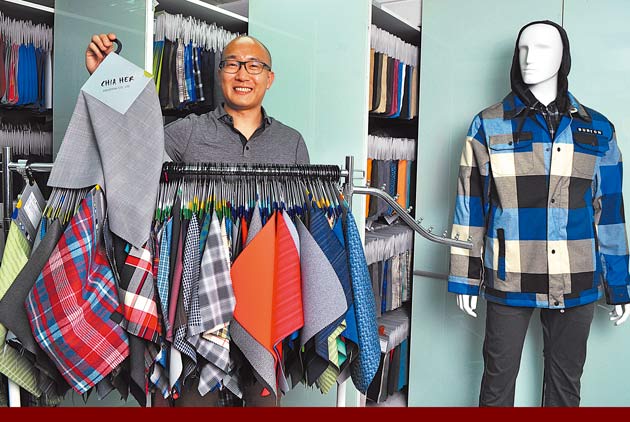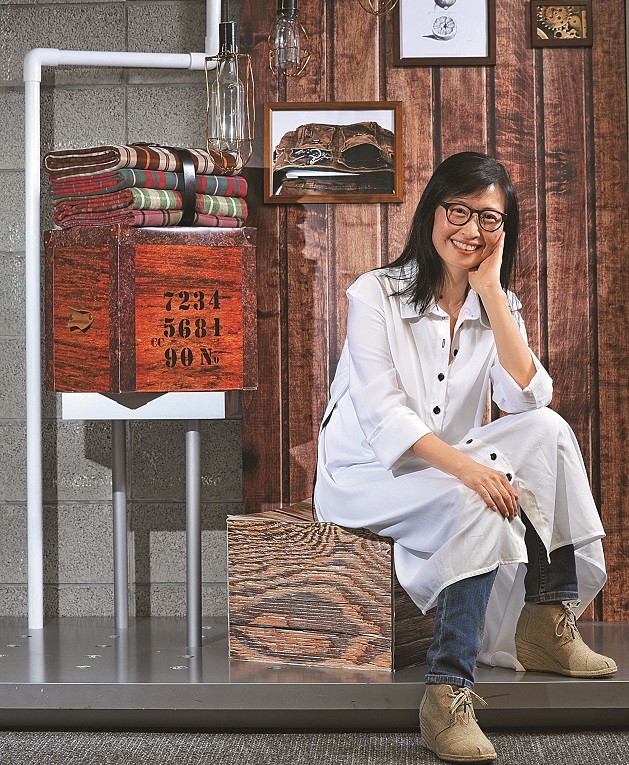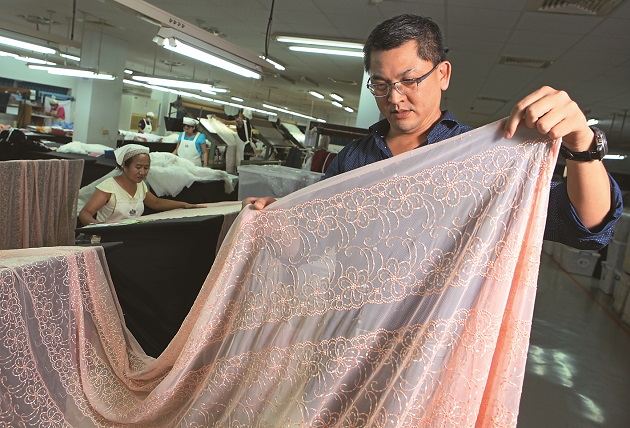The Secret behind Burberry, Coach and Victoria’s Secret

Source:CW
Does anyone connect Taiwan’s ancient capital of Tainan, famous for its majestic temples and delicious snacks, with fine fabrics and advanced functional textiles? Yet global fashion brands such as Burberry and Coach as well as lingerie maker Victoria’s Secret all source their fabrics here.
Views
The Secret behind Burberry, Coach and Victoria’s Secret
By Kuo-chen Lu, Kai-yuan TengFrom CommonWealth Magazine (vol. 583 )
People usually associate Tainan with gourmet food, delicious snacks, literature, the flair of an ancient capital, and a more relaxed pace of life.
Yet Tainan has also hosted an avant-garde fashion show featuring Taiwanese designers for four years in a row. This year’s show, the 2016 S/S Tainan X New Fashion Show, will be held at Anping harbor on November 7. Local designers, many of whom have studied at top fashion schools abroad, have teamed up with local fabric makers to create unique garments to highlight the city's creative potential.
Tainan is famous for its milk fish, which features high on almost every menu, be it as milk fish congee, fish skin soup or fish balls. However, few people know that Tainan locals have found a way to turn milk fish scales, a waste product that used to be discarded, into a valuable raw material for a novel fabric that has made it to the catwalks of Paris. The “collagen peptide fiber” fabric won the silver medal at the Concours Lepine international inventions fair in Paris this year.
Although Tainan produces neither wool nor cotton, a Tainan maker of woolen fabrics has won several spots in the Top Ten at the ISPO Textrends in Munich, the world's largest sportswear show, for three years in a row.
More importantly, these fabrics from Tainan are not only winning international industry awards, they have also attracted top customers from around the globe, including Lululemon, Under Armour, Burberry, Coach, Ralph Lauren, Tommy Hilfiger, and Massimo Dutti, the high-end brand of Zara mother company Inditex. Even American lingerie brand Victoria’s Secret and outdoor sporting goods brand Arc’teryx source fabrics in Tainan.
The local textile mills have been able to create a strong niche, making Tainan into a global fabrics empire because they can readily adjust to the changing industry environment and keep abreast of the international market.
Hermin Textile Co. Ltd.
Bringing Fish Scales to the Catwalks of Paris
The manufacturer of the best plaid fabrics in the world is hidden away on Dasheng Road in Tainan’s Annan District. Founded in 1976 by Chen Wen-jin, the company initially focused on woven plaid fabrics that mostly used natural fibers such as cotton, silk, linen and wool. Now it has become a supplier to luxury fashion brands thanks to the exquisite quality of its refined fabrics.
 Chia Her Industrial Executive Vice President Chase Wong, a third-generation wool fabrics maker, has successfully developed water-resistant, quick dry functional textiles from natural fibers such as wool and cotton, carving out a niche for the survival of Taiwan’s only remaining integrated wool textile mill.
Chia Her Industrial Executive Vice President Chase Wong, a third-generation wool fabrics maker, has successfully developed water-resistant, quick dry functional textiles from natural fibers such as wool and cotton, carving out a niche for the survival of Taiwan’s only remaining integrated wool textile mill.
Jeimy Lee, executive vice president of sales and marketing, who belongs to Hermin’s second-generation leadership team, wears a garment made of the novel fish collagen-containing fabric. “The reason why Tainan’s textile mills have been able to shine on the international stage is because we made the transition from conventional processing to creating intelligent value. We are not just a contract manufacturer; we also design products for our customers, explain our fabrics and go even further by teaching our customers how to use our fabrics to make apparel,” explains Lee.
Making fabric out of milkfish scales is quite complicated. First collagen peptide is extracted from the recycled scales and blended with biodegradable rayon fiber in an advanced nanotechnology process. The polymerized material is then pumped into yarn, dyed, woven or knit into fabric for use in garments.
Why use milk fish scales? First, Lee explains, the scales were originally discarded as trash although they symbolize a part of the local culture. Second, while the collagen derived from fish scales is not as good as collagen extracted from pig skin, fish collagen meets the requirements for Halal certification and is thus sellable around the world, including Muslim countries.
Over the past decades, some industry peers have gone public while others have developed upstream capabilities. Hermin, however, insists on using natural fibers such as wool, cotton, rayon and linen to make top–of-the-line plaids.
Chia Her Industrial Co. Ltd.
Favorite of Lululemon, Under Armour
Guantian, northeast of Tainan City, is home to another textile company that has worked a miracle: Although Taiwan produces neither wool nor cotton, Chia Her Industrial Co. Ltd. is selling wool and cotton fabrics to global leading sportswear brands abroad.
Chia Her Industrial Executive Vice President Chase Wong, the third generation to run the textile company, makes it a point to wear an outfit from two of his major clients – an Under Armour shirt and Lululemon pants. He explains how functional fabrics that blend Merino wool or cotton with man-made fibers have helped turn the company around.
In 1987, Chia Her boldly invested NT$3 billion in new textile machinery and equipment. The move shocked Taiwan’s entire industrial world at the time because the amount appeared huge in comparison to other investments. Taiwan’s largest carmaker, the Yulon Group, had just invested NT$2.4 billion in the production of its first homegrown car, the Yue Loong Feeling.
Having spent more than a car plant’s costs, Chia Her built the largest integrated textile mill in the world for cotton and wool yarn spinning, dyeing and fabric weaving. The new factory boasted the largest output in plaid fabrics worldwide.
But the lucky streak ended when China began to aggressively develop its cotton textile industry. Chia Her was not able to outstrip China's output and cheap prices. As a result, China grabbed the market for low-priced products and the once-unrivaled textile champion Chia Her became yesterday’s hero.
The company was dealt another blow a dozen years later when functional textiles became a global craze and international sportswear brands Nike, Adidas, Lululemon and Under Armour began to switch to functional fabrics. Chia Her’s expertise was in natural fibers such as wool and cotton, quite the opposite of the predominantly synthetic fibers used in functional textiles.
Wong knew he could not change the company’s fortunes if it continued in the same old rut. Therefore he began to experiment with wool and cotton, trying to figure out ways to weave these natural fibers into functional fabrics.
Wong takes a piece of fabric and explains that its outer synthetic layer is waterproof, whereas the inner cotton layer is moisture absorbent and quick-drying. The fabric has the soft feel of a natural fiber but is also functional. On top of that, it can be customized to order.
Such fabrics undergo complex and multilayered processing, which is very difficult. Let’s just talk about dyeing. Synthetic fiber dyeing takes only four to six hours, whereas natural cotton or wool require more than eight hours. Different materials have different properties, so the production processes from dyeing to weaving must be adjusted and changed accordingly. And then we need to produce the quantity that the customer needs," Wong points out.
Chia Her began to venture into the development of functional fabrics in 2006. Over nine years of painstaking efforts, it began reaping its first fruits as international sportswear and outdoor gear brands gradually switched to functional fabrics made from natural materials such as cotton and wool.
After a long dry spell, Chia Her finally began to see the light at the end of the tunnel. “Chia Her needed to hang in there, or else Taiwan would no longer have a wool textile industry,” notes Wong. His mission went beyond saving the family business, which had been founded by his grandfather Wong Chuan-pei. Wong wanted to secure a future for Taiwan’s only remaining integrated textile mill for woolen fabrics.
Liberty Tex Co. Ltd.
Seductive Fabrics for Victoria’s Secret
Leading lingerie makers Wacoal from Japan and Victoria’s Secret from the United States source their sheer, intimate lace fabrics from Tainan.
The same goes for Taiwan’s homegrown lingerie brand Mode Marie, which is based in Yuanlin, Changhua County. “Aside from fabrics, Tainan is a cluster for embroidered textiles. Virtually all embroidery comes from Tainan," notes Huang Ya-fen, head of marketing and planning at Mode Marie, the family business founded by her parents.
Just how big is Tainan's embroidery industry? “In the 1980s, Tainan had two large embroidery groups; one was Hsin Fu Hsing Industrial and the other Oriental Knitting. At the time, the Oriental Knitting factory in Shinshi had nearly 3,000 employees, and my father served as the company’s deputy general manager," remarks Bobby Chen, CEO of Liberty Tex Co. Ltd.
Founded in 1980, Liberty Tex started out with the production of tablecloths and table mats, and then added emblems and appliques. Subsequently, the company branched out into embroidered bridal gown fabrics and borders. Today it produces a wide array of embroidered fabrics and lace for lingerie, bridal dresses and fashionable apparel.
In that process, the company became increasingly export-oriented and moved up the value chain into high-end segments. Mode Marie’s Huang, who frequently visits lingerie-related international trade fairs, points out that embroidered fabrics makers from Tainan always have a strong presence there. The local embroidery industry spent more than a decade on going international.
Liberty Tex’s Chen notes that his company participates in trade shows in Paris twice a year. Over the past two decades, the company must have attended several hundred overseas trade fairs.
“In terms of quality, Taiwan is as good as Europe. The color libraries in Europe do not even offer as many colors as in Taiwan. The world's No. 1 in embroidery is Switzerland, which has accumulated some 1,000 colors. But Liberty Tex has already collected more than 2,000 colors," Chen remarks proudly.
High-end Fabrics Not For You
The color advantage helps at least partly make up for a challenge that Liberty Tex and the entire island face: The culture and personal environment, in which we grow up, shapes our personality and the way we see the world. Fashion designers in Germany and France draw designs that are very different from those of their Taiwanese colleagues.
 Bobby Chen (right), CEO of Liberty Tex Co. Ltd., holds up a piece of embroidered fabric that symbolizes the long history of the embroidery industry in Tainan. The company, which participates in Paris trade shows every year, has become an important supplier to the world’s leading lingerie brands.
Bobby Chen (right), CEO of Liberty Tex Co. Ltd., holds up a piece of embroidered fabric that symbolizes the long history of the embroidery industry in Tainan. The company, which participates in Paris trade shows every year, has become an important supplier to the world’s leading lingerie brands.
Somewhat frustrated about the lack of fashion sense in Taiwan, Chen notes with a sigh, “The embroidery patterns that we draw look like they were drawn by a village kid. The sense of the esthetic is completely different.” This leads us to another problem: Although Taiwan sells fine fashion fabrics to the world, it does not have a homegrown fashion industry that can complement the value chain.
Taiwanese fashion designer Pun Dai-lee, who heads the Tainan City Fashion Designers Union, feels that though the Tainan fashion show has been held four times, there is still a gap between fabric makers and designers.
“What the fabrics factories do is too broad, while what the designers do is too narrow,” Pun argues. Since the fabrics makers mainly produce for export, they make a wide array of fabrics that they sell to countries around the globe. However, Taiwanese designers often do not get to use the fine fabrics made in their own country.
Aside from staging fashion shows, the government should therefore come up with medium- and long-term strategies to realize synergies between the textile industry and fashion designers. Fashion shows should not be one-off isolated events but ring in a new integrated approach across industries to raise urban competitiveness.
Translated from the Chinese by Susanne Ganz






